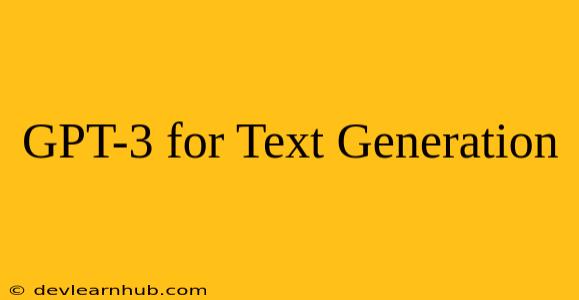Introduction
The world of natural language processing (NLP) has seen a revolution with the advent of large language models (LLMs), and among them, GPT-3 stands out as a remarkable achievement. Developed by OpenAI, GPT-3 (Generative Pre-trained Transformer 3) is a powerful deep learning model renowned for its exceptional capabilities in generating human-like text. This article delves into the intricacies of GPT-3, exploring its architecture, applications, and potential impact on the future of text generation.
Understanding GPT-3
GPT-3 is built upon the transformer architecture, a neural network design that excels at processing sequential data, such as text. It is trained on a massive dataset of text and code, encompassing a vast array of human knowledge and expression. This extensive training allows GPT-3 to learn complex patterns and relationships within language, enabling it to generate coherent and contextually relevant text.
Key Features of GPT-3
- Generative Capabilities: GPT-3 is adept at generating various forms of text, including articles, poems, code, scripts, and even musical pieces. It can mimic different writing styles and tones, making it highly versatile.
- Contextual Understanding: GPT-3 possesses a remarkable ability to comprehend context, allowing it to generate text that is both grammatically correct and semantically meaningful. It can seamlessly transition between topics and maintain a consistent narrative.
- Fine-tuning and Customization: GPT-3 can be fine-tuned for specific tasks and domains. By training it on a specialized dataset, users can tailor its capabilities to meet their particular needs.
- Zero-shot and Few-shot Learning: GPT-3 exhibits remarkable zero-shot and few-shot learning abilities. This means it can perform tasks without explicit training or with minimal examples, demonstrating its adaptability and flexibility.
Applications of GPT-3
GPT-3's impressive capabilities have opened up a wide range of applications across various industries:
Content Creation
- Article Writing: GPT-3 can assist writers in generating ideas, drafting outlines, and even creating entire articles, enhancing productivity and creativity.
- Social Media Content: GPT-3 can generate engaging and shareable content for social media platforms, helping businesses reach a wider audience.
- Blog Posts and Articles: GPT-3 can be used to generate high-quality blog posts, articles, and other forms of written content, providing valuable insights and information.
Customer Service
- Chatbots: GPT-3 powers chatbots that can engage in natural conversations with customers, providing support, answering questions, and resolving issues.
- Personalized Responses: GPT-3 can generate personalized responses to customer inquiries, enhancing customer satisfaction and building stronger relationships.
- Email Automation: GPT-3 can automate email responses, freeing up customer service agents to focus on more complex tasks.
Education
- Personalized Learning: GPT-3 can create personalized learning materials, adapting to individual learning styles and needs.
- Interactive Exercises: GPT-3 can generate interactive exercises and assessments, enhancing student engagement and understanding.
- Essay Grading: GPT-3 can assist educators in grading essays, providing feedback and insights on student writing.
Other Applications
- Code Generation: GPT-3 can generate code in various programming languages, simplifying development processes and reducing errors.
- Translation: GPT-3 can translate text between languages, breaking down communication barriers and facilitating global understanding.
- Creative Writing: GPT-3 can be used by writers to generate ideas, characters, and storylines, fueling their creative endeavors.
Benefits of Using GPT-3
The use of GPT-3 offers numerous benefits:
- Increased Efficiency: GPT-3 automates tasks, allowing businesses and individuals to focus on more strategic initiatives.
- Enhanced Creativity: GPT-3 can generate new ideas and perspectives, fostering creativity and innovation.
- Improved User Experience: GPT-3 delivers personalized and engaging experiences, enhancing customer satisfaction and loyalty.
- Reduced Costs: GPT-3 can streamline processes, reducing operational costs and increasing efficiency.
Challenges and Ethical Considerations
While GPT-3 presents immense potential, it also comes with challenges and ethical considerations:
- Bias and Fairness: GPT-3's training data may contain biases, potentially leading to biased or unfair outputs.
- Misinformation and Deepfakes: GPT-3 can be used to generate fake news articles or create convincing deepfakes, raising concerns about information integrity.
- Job Displacement: GPT-3's automation capabilities may lead to job displacement in industries where tasks can be automated.
- Privacy and Security: The use of GPT-3 raises concerns about privacy and security, as it requires access to sensitive data.
The Future of GPT-3 and Text Generation
GPT-3 is a groundbreaking technology with the potential to revolutionize text generation. As the model continues to evolve and improve, it is likely to play an even more significant role in shaping the future of various industries. Here are some key trends to watch:
- Advancements in Model Architecture: Research is ongoing to further improve GPT-3's architecture, potentially leading to even more powerful and versatile language models.
- Increased Accessibility: GPT-3 is becoming more accessible to businesses and individuals, making it easier to leverage its capabilities.
- Integration with Other Technologies: GPT-3 will likely be integrated with other technologies, such as voice assistants and augmented reality, creating new and innovative applications.
- Ethical Considerations: As GPT-3 becomes more widely adopted, ethical considerations will remain paramount, ensuring its responsible and equitable use.
Conclusion
GPT-3 represents a significant leap forward in text generation technology, offering a glimpse into the future of human-computer interaction. Its ability to generate human-like text, understand context, and adapt to diverse tasks makes it a versatile tool with wide-ranging applications. While challenges and ethical considerations need to be addressed, GPT-3's potential to enhance productivity, creativity, and communication is undeniable. As this technology continues to evolve, it will undoubtedly shape the way we interact with language and create content in the years to come.
